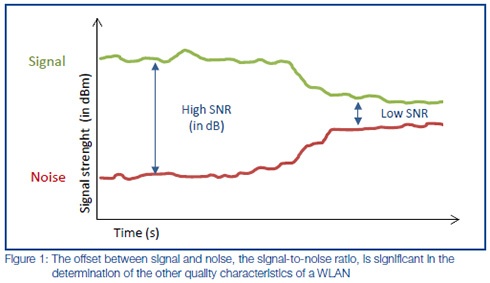Demystifying and Optimizing Industrial Wi-Fi
Are you new to industrial Wi-Fi and worried about perceived reliability issues? Many companies worry wireless local area networks (WLANs) are unreliable or only available for (or useful with) new equipment and state-of-the-art applications. Wireless technologies are no longer a luxury or bonus. They’re mandatory for modern industrial networking. As the Industrial Internet of Things (IIoT) drives changes on the factory floor, wireless infrastructure is the central nervous system that keeps everything functioning.
Today’s Optimized Industrial Wi-Fi – Built to Meet Your Network’s Demands
Before high-speed Wi-Fi became ubiquitous, transmitting data without physical connections seemed like science fiction. In many industrial applications, Wi-Fi feels more like the villain instead of the hero of that story. The promise of the IIoT never seems fulfilled because of unpredictable and unreliable connections as more connected applications come to the factory floor.
Today’s factories are rewriting that story by investing in better Wi-Fi optimization. Too often, poor connectivity is caused by building an industrial WLAN with consumer-grade components. If a power drill you buy at the local Wal-Mart can’t hold up for use on the factory floor, why should we expect an off-the-shelf wireless router to deliver reliable results?
There are many environmental factors and configuration considerations that can affect WLAN performance in industrial settings. But, these issues significantly diminish with infrastructure actually created for industrial applications.
Identifying if Your Industrial Wi-Fi Needs an Upgrade: The Five Symptoms
Imagine you are sick and go to the hospital. The nurses start by asking “Why are you here today?” They want to know your symptoms so the doctor can diagnose what’s ailing you. If the doctor only treated those symptoms, you might feel better for a few days. But the real issue would continue, and your symptoms could soon return.
When your industrial Wi-Fi isn’t performing, there are five symptoms that will help you diagnose what’s causing the illness. These five symptoms are likely what’s making you nervous about upgrading your industrial Wi-Fi or switching from a wired network. Unmasking what’s behind the symptoms will help you diagnose if your industrial Wi-Fi is poorly configured or if the network is failing for a different reason.
1. Packet Loss Rate
What is it? We’ve all experienced a slow Wi-Fi connection. Did you know packet loss rate is the leading indicator of a network with continuing speed problems? Packet loss rate is the percentage of sent messages (or packets/frames) not received successfully by the intended recipient. Lost packets slow down the communication since they need to be re transmitted. Moreover, lost packets can severely affect the reliability of your network and your applications because critical signals aren’t making it to their intended destination.
What is a healthy packet loss rate? 0.1 percent or less. You know you have an unhealthy packet loss rate if you’re seeing values that are significantly higher than 0.1 percent. In noisier industrial environments, you may see rates as high as 2-3 percent.
2. Latency
What is it? Often generalized as “lag,” latency is the delay in transmission for the delivery of a message via a wireless connection. Packets – the way data travels over WLANs – don’t travel through the air instantly. Each transmitter/receiver a packet must travel through introduces a delay of a few milliseconds. In busy networks, the transmitter may have to wait for many other transmissions to complete before It can even send a specific packet.
What is a healthy latency? A few milliseconds in the best case. In the worst cases, a healthy latency should still be less than 50-100ms. In an industrial network with low tolerance for communication latency, anything more than 100ms is cause for concern.
3. Data Throughput
What is it? The ability to reliably transmit a certain amount of data over a specified time. The higher and stronger the throughput, the better the network. Think of the network as a highway: If cars can move down the road at a certain speed, the bandwidth tells us what the maximum capacity of cars that can come down the highway over a specific time period. However, circumstances, like lane closures and accidents, reduce the number of cars that can maintain speed and forward movement on that highway over the same period – this is throughput.
What is a healthy throughput? This will be determined by how much data your application needs to transmit.
4. Interruption
What is it? An interruption is a break in the transmission that takes place when a client/device roams from one access point to another. In applications, such as trains or autonomous vehicles, a device must connect to different access points as it moves throughout the network. Think of a series of overlapping Venn diagrams – the overlap gives the device an opportunity to remain connected to one access point while it connects to another access point.
What is a healthy interruption? Few, low-impact interruptions (e.g., less than 50ms) are acceptable. But anything higher than 50ms or designated as high-impact or a great frequency of interruptions would be unhealthy.

Wireless technologies are no longer a luxury or bonus; they’re mandatory for modern industrial networking.
5. Range
What is it? The area included by an access point. Range also describes the seamlessness in the coverage of a facility that determines whether the WLAN connections are strong enough to reach all necessary locations. Ranges can be large or small, depending on the design and objectives of the specific network, but stronger networks typically have longer ranges.
What is a healthy range? Like throughput, a healthy range depends on your specific needs and application.
So, what’s the prescription for your sick industrial WLAN? For some symptoms, like range and throughput, it can be as easy as ensuring your equipment is suited to fit your demands. But even then, treating the symptoms won’t fix the real problem. Based on these symptoms, the way to solve these issues is to fix your signal-to-noise ratio (SNR).

Signal-to-Noise Ratio: The Secret to Industrial Wi-Fi Optimization
If your SNR is low, your WLAN performs unreliably – just as you feared.
Every data transmission contains signal and noise. Signal is the transmission of desired data, and noise is comprised of everything else (interference, fragmented data, etc.). The SNR is the difference between the level of signal and noise.
Consider the last time you had a conversation at a party: speaking at a comfortable volume, your voice can be heard only as well as the noise around you will allow. As the room gets louder, it is more difficult to have your voice heard, and you find yourself talking louder and having trouble understanding the conversation. The message delivery ultimately slows down.
Likewise, in data transmission, low SNR makes it difficult for the signal to be “heard.” In this case, the WLAN devices can communicate with each other only when they transmit their data very slowly and clearly. High SNR means there is more signal than noise, and transmission can take place at higher speeds.
So how do you ensure a high SNR? New technologies, such as adaptive noise immunity, client or band steering and Parallel Redundancy Protocol (PRP) can significantly improve the performance, reliability and transmission latency of wireless networks in industrial settings. By making sure WLAN quality is at its highest through these new technologies, you can maximize uptime and avoid costly disruptions to the network.
A high SNR is the most important goal of a full-functioning, optimized WLAN. Without it, it’s impossible to achieve the reliable wireless network you’re looking for.
In medicine, there’s no “magic pill” to cure all illnesses. In WLAN optimization, fixing poor SNR comes close.
Looking for even more specific information on the steps you can take to optimize your system? Be sure to read our IEEE 802.11 Radio Optimization white paper.
